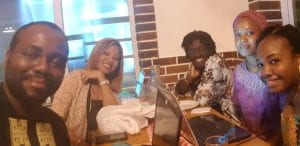Guest blog written by Adepeju Francis-Abu, Beatrice Izeagbe Okpara, Kennamdi Charles Onwuliri, Lami Wendy Adams, Pemwa Danbaba.
This is a team from Nigeria working for the Federal Ministry of Justice, Government Agencies and the private sector. They successfully completed the 15-week Practice of PDIA online course that ended in December 2018. This is their story.

Our team is an interesting mix of people from different organizations within and outside the Nigerian public service and was peculiar because only one of us had prior experience in development work. However, we were all driven by an interest to make a difference within our environment with the hope that the effect would eventually cascade to the entire public service, hence the group name Team RRN (Reform and Rebuild Nigeria).
In the past 15 weeks we’ve expanded our perspective, network, acquired some vital skills in problem solving through PDIA and gained an entirely new perspective on designing solutions by learning to take little and realistic iterative steps towards small & quick wins.
A major takeaway for us individually and as a team was learning to construct and deconstruct our problem using analytical tools like the 5-whys, fishbone diagram, and triple A change space analysis which enabled us to properly assess our problem and determine its true nature and components. Unsurprisingly, during the deconstruction exercises, our team’s initial problem morphed into the streamlined problem statement we eventually focused our engagement on.
In addition, we gained an important lesson “crawling the design space” that we could combine best practices with other practices (latent practice, existing practices, and positive deviance) to achieve desired results. We surprisingly found out that the emergence of ideas could come from latent and positive deviance space, like our serendipitous discovery in the second week of iteration.

Indeed, the most promising idea capable of changing the face of service delivery in the Federal Ministry of Justice (FMOJ), emerged from exploring the positive deviance domain in the Department of International Law, where the existing Document Management System has proven to be effective in addressing issues relating to cumbersome paper trail, hoarding of files by front desk officers and inefficiency in task delivery.
We learnt invaluable lessons about team dynamics and how teamwork translates to results. Teamwork is an ever-consistent feature in the work space and thanks to this experience, we are better equipped to navigate that space more than ever. We had two lawyers in our team of five who actively engaged in the FMOJ, two members were staff of Government Agencies and one from the private sector. The non FMOJ team members learned about the influencers, authorizers & stakeholders relating to the FMOJ and some ‘legal lingo’.
Our ideas about leadership changed as we explored the concept of multi-agent leadership as opposed to idolized or fantasized hero-leaders. We realised that effecting change in any context is a collective effort of likeminded people working towards the same goal, under a very committed, visionary and highly permitting Leader.
Another highlight of our learning experience was the importance of contextualising- finding solutions to fit our problem rather than buying ready-made solutions and forcing our problems to fit them. We found the process of deconstructing our problems into various causal strands exciting to explore as it became obvious that our main problem resulted from an intricate web of cumulative failures and shortcomings.
We approached our iteration week with mixed emotions, excited yet cautious of the possible challenges we may encounter, which we did! Despite the short timeframe, we recorded some progress, where some of our assumptions were debunked, others confirmed.
When engagement commenced, it was key that we were able to expand change space by securing some level of authorization and acceptance especially among the mid-level authorisers. Despite the limited period, we were able to create an opening for engagement and intend to follow-up on progress made over the coming weeks & months, to sustain our momentum and expand our authority to effect the desired change. As authority fades when the initial euphoria starts to diminish.
It is revealing and encouraging to learn that there are no failures in the PDIA process, as the outcome of every iteration is a learning opportunity. Where an assumption is proved wrong or inadequate, it is not perceived as a failure but provides a platform to re-strategize and find alternatives to the problem.
The PDIA process is applicable in everyday situations and has become part of our tacit knowledge. We look forward to applying PDIA in future projects individually in our various organizations. For Team RRN, it has been an awesome experience, though daunting at most times as it did take a lot of adjusting and fitting in with our already hectic work and family commitments, but we all agree we will do this again in a heartbeat.
We intend to stay on as a group, meeting up socially and have talked about continuing our PDIA work beyond the FMOJ. We have developed a special bond in the last 15 weeks and shared personal experiences. Amongst ourselves, we’ve had two medical emergencies, a heavily pregnant team member, work and personal trips, highs and lows, but we’ve managed to deliver on our deadlines! What we thought would be an arduous task turned into an all-round amazing experience.
Is this the end of the road for Team RRN? Far from it!!
To learn more, visit our website or download the PDIAtoolkit (available in English and Spanish).
